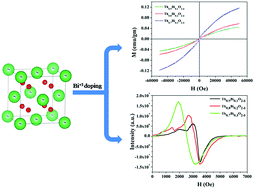New thorium–bismuth oxide solid solutions with oxygen vacancy induced tunable ferromagnetism†
Abstract
A combined X-ray diffraction (XRD), extended X-ray absorption fine structure (EXAFS) spectroscopy, and magnetic and electron paramagnetic resonance (EPR) study on defect-induced magnetism in Th1−xBixO2−δ (0 ≤ x ≤ 0.3) solid solutions is presented in this paper. The solid solutions were prepared through a solid-state reaction route. The XRD patterns of the solid solutions suggest Bi dissolution up to 30 at% in the ThO2 matrix. The EXAFS study at the Bi and Th L3 edges indicates the formation of oxygen vacancies near Bi sites with an increasing trend with the Bi at% in the solid solutions. The magnetic measurements in field cooled (FC) and zero field cooled (ZFC) mode indicate an interesting observation involving ferromagnetic ordering with Curie temperature at around 70 K. The possibility of a spin glass-like phase was conclusively ruled out by a memory effect test experiment. The EPR studies revealed the presence of two different signals at g ∼ 2.05 and 2.25 due to the paramagnetic oxygen vacancy ( ) and ferromagnetic resonance (FMR). The constant increase in intensity of the FMR signal with increasing doping level corroborates well with the increasing saturation magnetization value in magnetic measurements. By lowering the measurement temperature, this FMR signal showed an increase in its intensity along with continuous broadening and shift of the resonance field position to the lower field, which further signifies the presence of ferromagnetic ordering due to the paramagnetic oxygen vacancy in the Th1−xBixO2−δ solid solution.
) and ferromagnetic resonance (FMR). The constant increase in intensity of the FMR signal with increasing doping level corroborates well with the increasing saturation magnetization value in magnetic measurements. By lowering the measurement temperature, this FMR signal showed an increase in its intensity along with continuous broadening and shift of the resonance field position to the lower field, which further signifies the presence of ferromagnetic ordering due to the paramagnetic oxygen vacancy in the Th1−xBixO2−δ solid solution.



 Please wait while we load your content...
Please wait while we load your content...